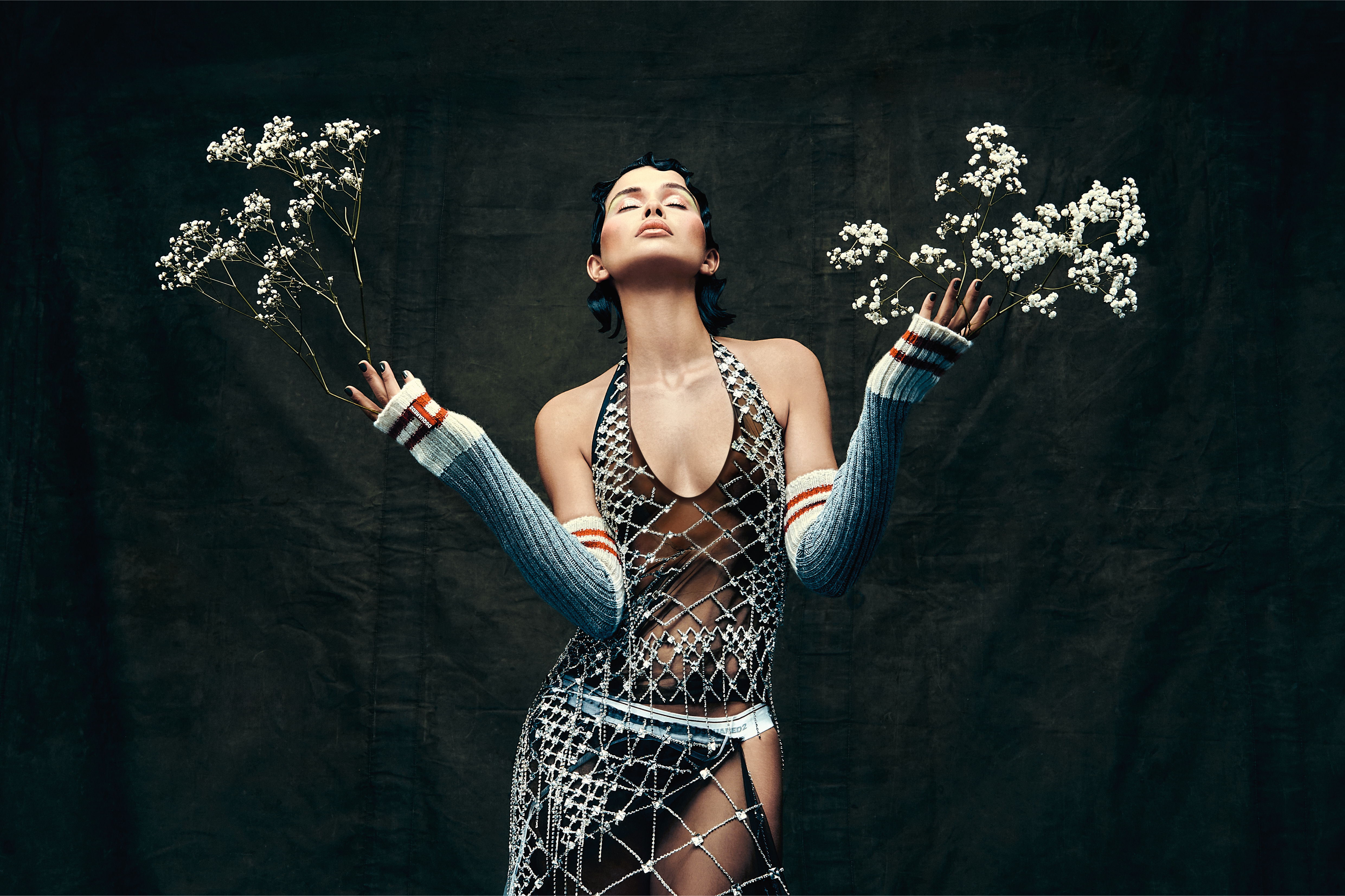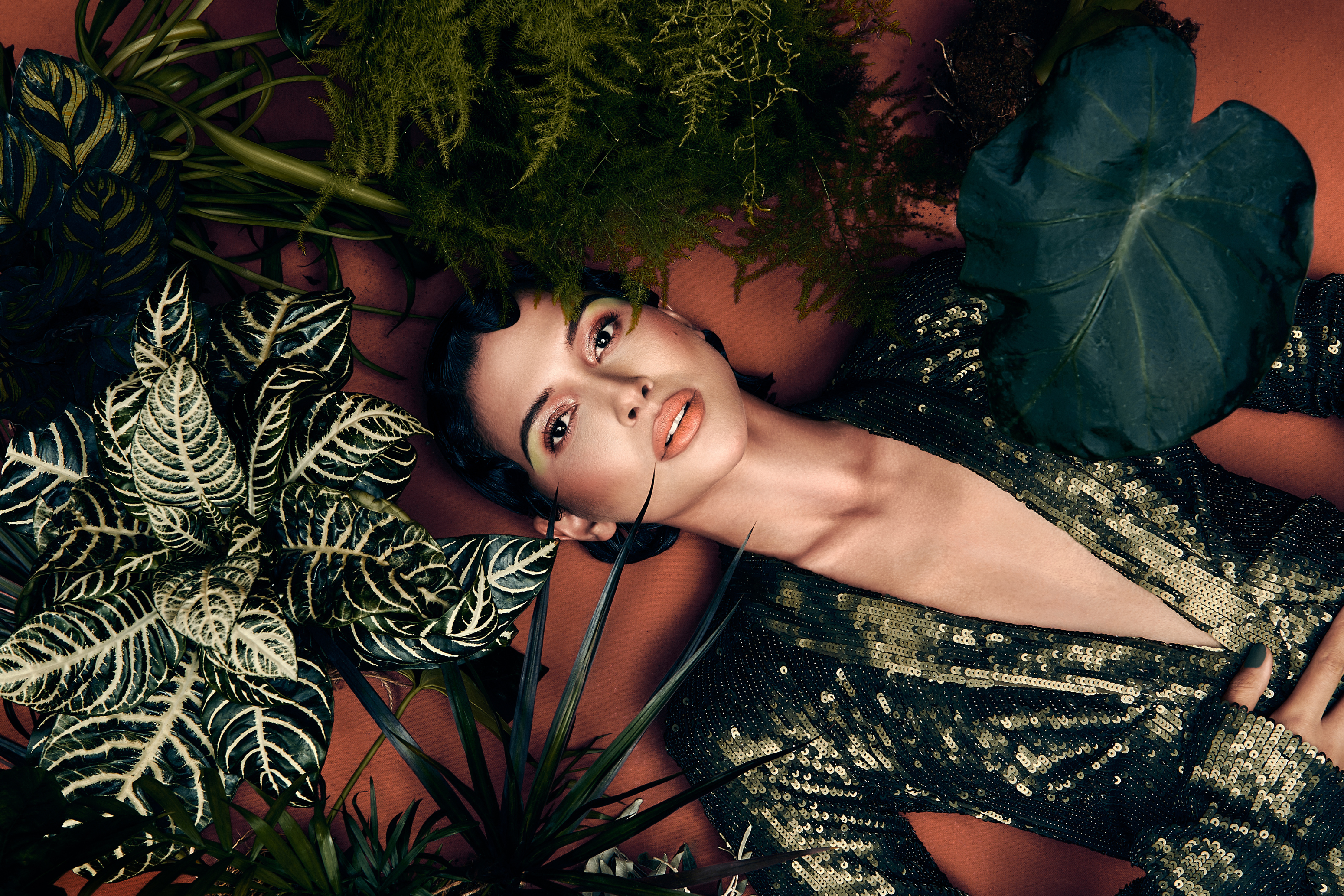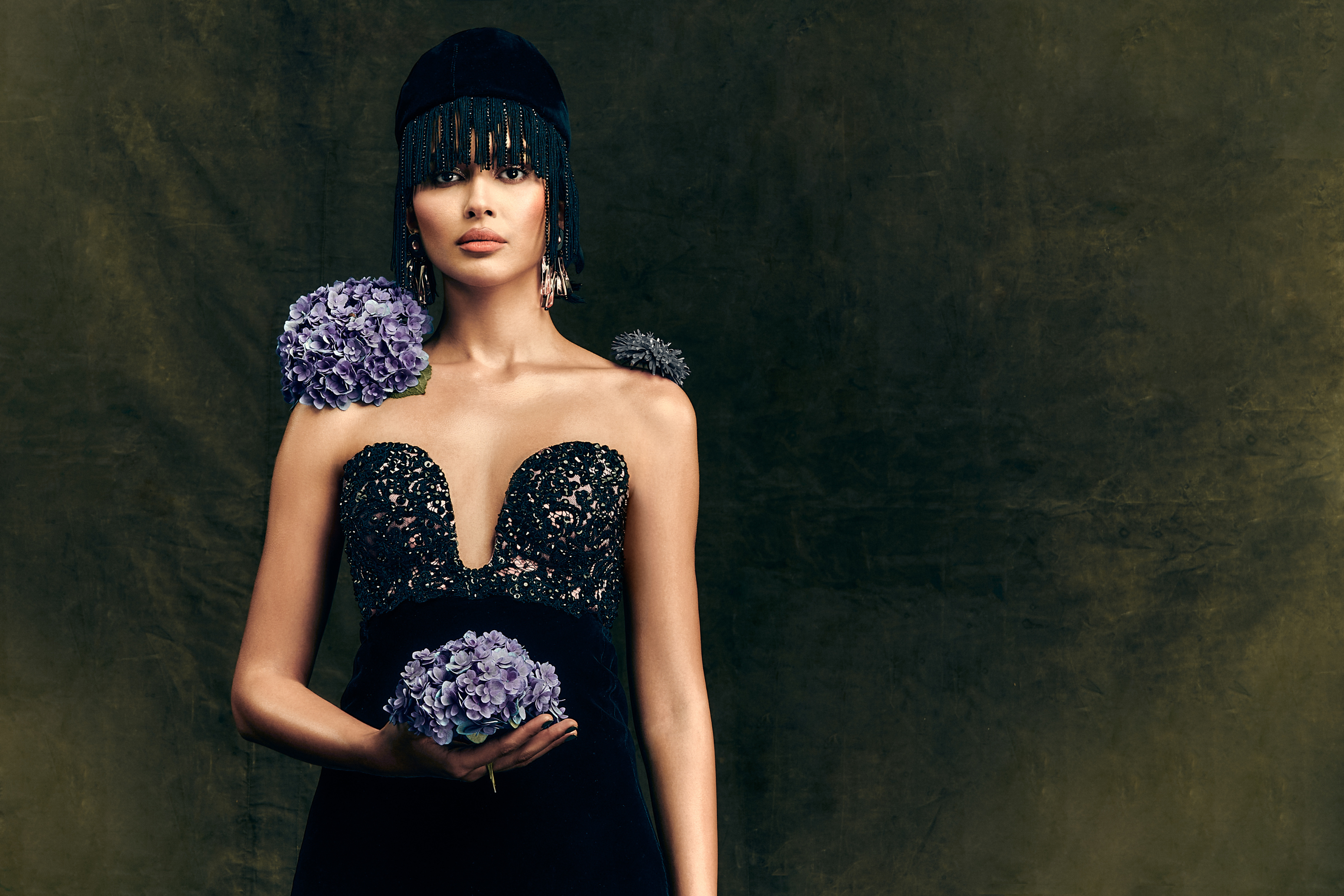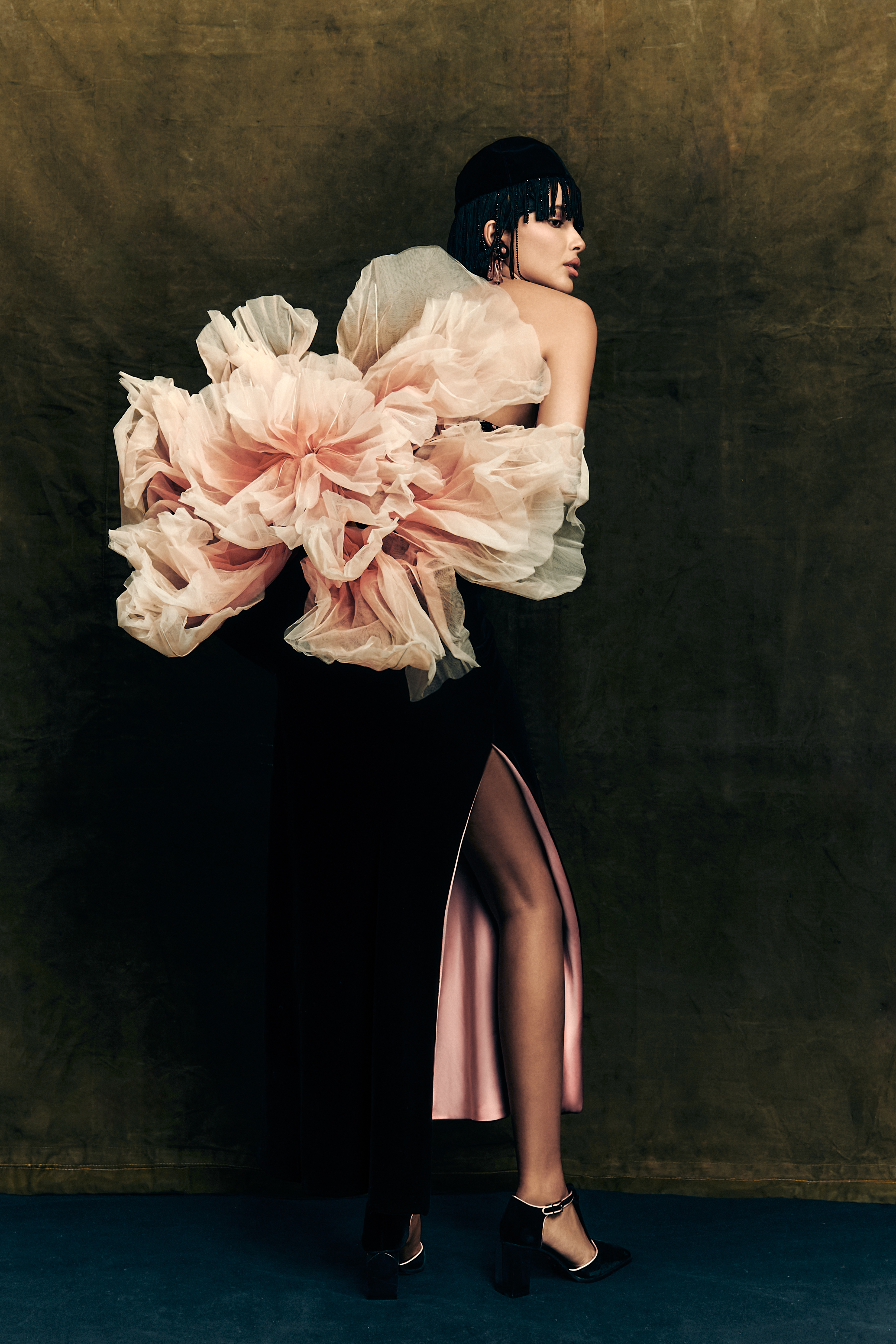
There’s no beating around the bush for Azza Slimene. She’s here to make a difference and she wants people to know that.
“I want to change the narrative,” she tells me when we sit down together after her photo shoot for GRAZIA. What exactly does she mean by this, I ask. “I just feel like it’s really my duty, that I’m not just there for showcasing dresses and clothes. I want to show what’s happening in the world and be the voice for people who don’t have a voice.” That’s a huge declaration for a 26-year-old to make, but it’s crystal clear she means every word of it.
Born and raised in Tunisia, Azza is the youngest of eight girls. Growing up, Azza’s family was very tight-knit, but being the youngest, at times she felt she had nine parents. “Because I was the youngest, everyone was trying to parent me, even my sisters,” she recalls. “But we all love and support each other; it’s a modest family.” While she may not have travelled internationally much when she was younger – unlike nowadays – Azza explored the many facets of Tunisia with her family. “I visited a lot of cities in my country, trying to discover more about our history, traditions and culture,” she explains. “It’s beautiful, you know, we have the beach, the desert and so many interesting parts of our culture.” However, Azza admits parts of her formative years were also challenging. “Women were not as free as men,” she states bluntly. “So, that’s the difficult part.” In particular, Azza describes the “social boundaries” she met when it came to following her passions in the world of fashion.

Azza can’t exactly pinpoint when she fell in love with fashion and resolved to pursue modelling; it was just a “gut feeling deep down” that it was what she was meant to do. “I knew I could bring something to the table,” she asserts. “I know I’m able to help designers express themselves through me, making their vision come alive.” This self-assurance must have been evident from the first meeting, because the individual who ‘discovered’ Azza in 2017 was none other than fellow Tunisian, designer Azzedine Alaïa, just months before his passing.
While studying at university, Azza had taken up modelling and was scouted by Next Models in Tunisia. “Azzedine called me his ‘belle plante’,” she recalls, which means ‘beautiful specimen’. “He told them, ‘I need this girl in France; I need her in Paris. I need to work with her.’” The next thing she knew, she, along with all of her belongings, was on her way to the designer’s home in Paris. There was only one other person Alaïa is known to have mentored on this level – one of the most successful supermodels in the fashion industry, Naomi Campbell.
Looking at it from this perspective, it seems like Azza’s trajectory to fashion stardom was simple. Get discovered by one of the most celebrated couturiers of the last century, move to Paris, become a supermodel. And the rest, as they say, is history… But not quite. It’s been, as Azza describes it, “a long journey”. “My parents did not accept me as a model,” she reveals. It went against what she was taught, her culture and what was expected of her. Deemed a ‘bad profession’, Azza had to “show them what modelling was really about.” At that time – just over six years ago – Arab models were few and far between. “It was an impossible dream,” Azza declares. Met with doubt not only from her parents but also her peers, she was encouraged to forget about her dream to break into the fashion industry, highlighting it was largely down to the fact she didn’t meet the ‘white standards of beauty’. But Azza was undeterred.

Just one year after being discovered by Alaïa, Azza made her debut at Paris Fashion Week, modelling for Chanel’s Fall/Winter 2018 collection. It was a turning point not only for her career, but also for her parents’ understanding of her journey. “It’s the first time they finally understood the profession,” she says. The milestone was covered by regional and international media, platforming Azza on the global fashion stage, something she is utilising to break down barriers in the fashion and modelling space. She’s here to break stereotypes of the so-called typical model. “I think it’s no secret that the modelling industry has for decades been very Eurocentric,” she highlights. “There has been no diversity. For too long the traditional definition of a ‘model’ has been an incredibly skinny, very tall, blonde – basically white beauty standards and very few Arab models. So I feel like I’m breaking boundaries and challenging social norms by being Tunisian-North African-Arab, working with the biggest brands… I feel like I’m doing a great job to inspire young women.”
And it’s not just something she feels – it’s evident. With a following of over two million on Instagram, she is constantly flooded with messages from young people calling her their idol. “It’s a big word. It is really overwhelming,” she admits. But Azza is also well aware she has become the representation she didn’t have when she was growing up. “When I was young, I was wishing to find an idol from my country doing big shows or being the voice of women,” she explains. “So that’s why I’m trying to do my best to be a positive force on social media by discussing women’s rights, talking about modelling in a positive light and discussing body shaming – they’re pushing me to do my best.”
And she’s not afraid to discuss hard-hitting issues, such as women’s rights in Iran. “I want the world to see what’s really happening there,” Azza states. By this she is referring to the outrage which followed the death of Mahsa Amini, a 22-year-old Iranian woman who died in custody after being detained by Tehran’s Morality Police, who alleged Mahsa was violating dress rules pertaining to the hijab law. This resulted in uproar and protests – arguably the biggest the country has seen in over two decades – from many in Iran, mainly women, to bring an end to the compulsory hijab law. It’s been described by The Guardian as “biggest challenge for the clerical leadership since the 1979 revolution”.
“It was the Iranian women who inspired me to speak up – they are so courageous,” Azza comments. “I just listened to their voices, you know. It’s hard to support them in a way that we wish we could. But I feel like I can; I could support them with sharing posts by allowing the world to see the truth and what’s really happening there. Because the mainstream media is not sharing their voices, they’re not showing the truth, so I feel it’s like, my duty to do that as a woman.” Azza often meets with backlash for speaking on such issues. This takes the form of people unfollowing her, horrendous hate messages and even threats. However, she doesn’t let that affect her speaking up on such issues. “I really don’t care,” she says, dismissively. “I’m not doing good for followers or to make people love me, you know; I’m doing this to show the truth and to raise awareness. And I will not stop.” It goes hand-in-hand with her high-profile modelling career.

Not only is she travelling the world for her fashion career, but she’s a keen human-rights activist, advocating for women, working as an ambassador for the International Federation for Human Rights. “I love modelling, but I don’t want to just be a beautiful model. I want to work with organisations to platform the voices of people who don’t have a voice, to make a change,” Azza declares. “I don’t want to just be beautiful and show clothes, I want to use it in a more important way.” Azza is directly involved in the defence of human rights, especially with women’s rights and the environment, working with the federation.
Regardless, Azza is thankful for what modelling has afforded her, and she believes Alaïa is still watching over her. “He’s like a spiritual father for me,” she says. “He’s guiding me.” And it’s what she loves to do, which was obvious during her fantastic GRAZIA photo shoot. “I felt like a flower in the ground, you know? It’s really spiritual, in a way it’s like connecting with the Earth,” she says. But what she noticed, most of all, was the team. “There were so many women! The photographer, the art director, the styling, the set design. It’s so amazing to see a lot of talented women in the industry across all spaces,” she enthuses.
Azza Slimene isn’t just here to be ornamental, but to be a strong voice for Arab women too.
PHOTOGRAPHY: ESRA SAM
FASHION DIRECTION: ANNA CASTAN
HAIR: JEAN-LUC AMARIN
MAKEUP: ANDREY SEBAOUN
LIGHTING ASSISTANT: FAYCAL BOUHASSOUM
MANICURIST: NAFISSA DJABI
STYLING ASSISTANT: GABRIELA CAMBERO
TALENT: AZZA SLIMENE
WORDS: OLIVIA MORRIS
“DREAM BIG” IS PUBLISHED IN THE 7TH EDITION OF GRAZIA MIDDLE EAST ORDER YOUR COPY HERE.









